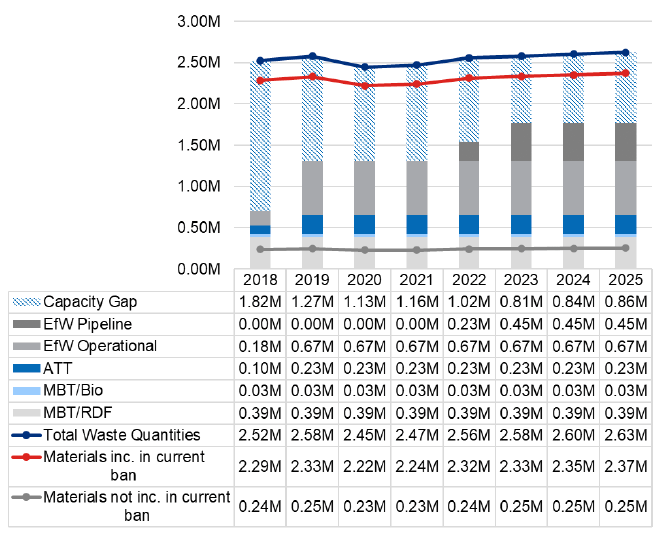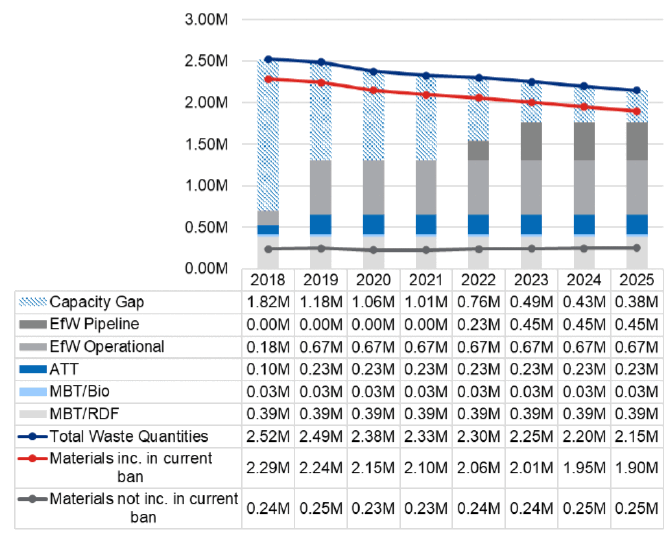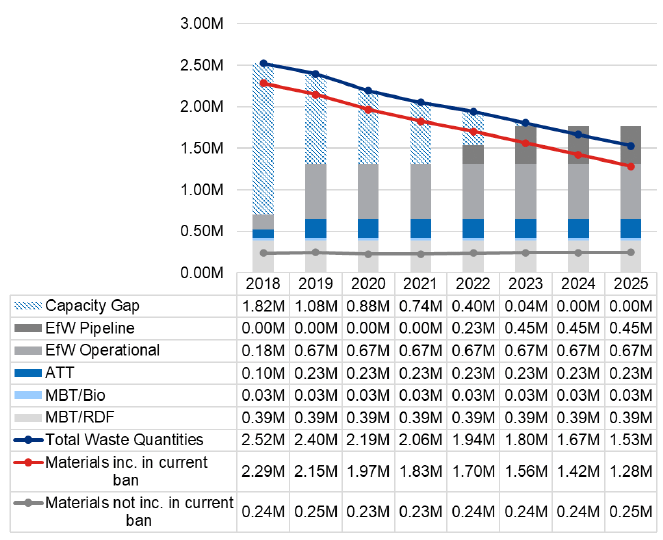Role of incineration in the waste hierarchy - review: call for evidence
The call for evidence seeks your views and evidence relating to the review of the role of incineration in the waste hierarchy.
5. Topic 1: Capacity Analysis
In light of the ban on sending biodegradable municipal waste (BMW) to landfill, by 2025, Scottish Government, through ClimateXChange (CXC)[11], commissioned work to assess the residual waste capacity required to treat Scotland's residual waste.
The work also considers the impact of extending the ban on landfilling biodegradable waste to C&I waste streams in light of Scottish Government's commitment to extend the ban to biodegradable non-municipal waste streams[12].
This work is due to be published by CXC during the course of the Review and our analysis will be updated accordingly. In the meantime, we are presenting a draft version of the initial analysis here to give an indication of the current evidence to help identify gaps where additional data from stakeholders could add value to the analysis. It should not therefore be taken as the final version and figures and estimates cannot be used or reproduced as such.
A full methodology is available in Annex 1. Briefly, the most recent Waste from All Sources data available (2018)[13] is used to consider three scenarios:
- A baseline scenario, where the waste produced fluctuates only with economic activity and the proportion of household (HH) and commercial and industrial (C&I) waste recycled remain at 2018 levels.
- An 'approaching targets' scenario where the amount of HH and C&I waste produced reduces by 7.5% of 2011 levels, and 59% of each waste stream is recycled. This scenario is similar to the scenario considered by the Waste Markets Study in 2019[14].
- An 'achieves targets' scenario, where the amount of HH and C&I waste produced reduces by 15%, and the recycling rates achieve 70%[15].
Each scenario is split into two showing the waste considered to be captured by the BMW ban (Scenarios 1a, 2a, 3a), and the waste captured under the extended ban (Scenarios 1b, 2b, 3b). Scenarios 1a, 2a, and 3a are shown below (5.1), and the extended ban scenarios are summarised below (5.2).
All scenarios assume that:
- the market for refuse derived fuel (RDF) will continue and around 0.4 Mt of material will be processed through this route and treated outside of Scotland.
- the facilities producing RDF are producing this to export this waste out of Scotland.
- all biodegradable waste captured under each ban (see Annex 1) will be diverted away from landfill.
- no hazardous waste is incinerated in facilities accepting municipal and C&I waste.
- incineration facilities operate at 95% of their permitted capacity, and all those in the pipeline are built and become operational by 2025.
5.1 BMW capacity analysis results
Baseline Scenarios
Baseline scenario 1a assumes that Scotland continues with 'business as usual' including the BMW landfill ban, and the results are shown in Figure 3. In 2025, the total waste quantities are estimated to increase to approximately 2.63 Mt and 2.37 Mt for the materials included within the scope of the landfill ban. This is due to the increase in waste growth and stagnation of recycling rates as outlined within the scenario assumptions.

Under this scenario, the results indicate that a capacity gap will be evident when the landfill ban is due to be implemented in 2025. This capacity gap equates to approximately 0.60 Mt for the materials included within the current BMW ban. This capacity gap is still evident in 2025 despite pipeline infrastructure due to become operational and phased in from 2022.
Approaching targets scenario
The approaching targets scenarios assume Scotland progresses around half-way towards the targets (when compared to the baseline scenario). The overall waste reduction and recycling targets could be met depending on the amount of construction and demolition (C&D) waste generated and recycled.
Scenario 2a (Figure 4) shows the results of applying these assumptions alongside a ban on landfilling BMW by 2025. The waste quantities after 2018 are projected to decrease to approximately 2.15 Mt for the total waste quantities and approximately 1.90 Mt for the materials under the scope of the current BMW landfill ban.

Under this scenario, a capacity gap is estimated for 2025 when the BMW landfill ban is due to be implemented. The capacity gap is approximately 0.13 Mt for the materials within the scope of the current BMW ban.
Achieving targets scenarios
The achieving targets scenarios assume Scotland achieves its policy targets. These policy targets are applied to HH and C&I waste only (i.e. excluding construction and demolition waste) for this analysis. The results of these assumptions applied alongside a ban on BMW (Figure 5) are shown below. The total waste quantities show a decrease to approximately 1.53 Mt in 2025 within this scenario. This is as a result of achieving the waste reduction targets and increased recycling as outlined within this scenario. For the materials within the scope of the BMW ban, this decreases to approximately 1.28 Mt in 2025.

Figure 5 suggests that there could be an excess capacity of around 0.49 Mt from 2024 onwards. Therefore, under this scenario where all policy targets are achieved, the results indicate that there would be sufficient treatment capacity to meet the waste captured under the ban, assuming all pipeline treatment infrastructure (see Annex 1) becomes and remains operational.
Summary and questions
Table 1 provides a summary of the potential differences in infrastructure capacity and residual waste.
| 2025 Capacity Gap Summary | Baseline | Approaching Targets | Achieving Targets |
|---|---|---|---|
| Total waste quantities | 0.86 Mt | 0.38 Mt | -0.23 Mt |
| Materials within scope of the ban | 0.61 Mt | 0.13 Mt | -0.48 Mt |
However, there remains a number of uncertainties in the analysis which additional evidence and information could help clarify.
Q7 How much capacity do you think we need to build given the current waste produced, managed and disposed of in Scotland, as well as Scotland's waste and recycling targets? What evidence do you have to support this?
Q8 It is suggested that the development of incineration capacity could lead to a 'lock-in' effect which will prevent waste from moving further up the hierarchy to be reused or recycled. What evidence do you have about these valid concerns? How do we prevent this lock-in effect, if it is a real risk?
5.2 Extending the ban capacity analysis
The analysis also considers the impact of expanding the ban to include biodegradable C&I waste streams. In general, there is only a small impact of including C&I waste streams, with an increase of around 0.04 Mt of waste captured under the ban in 2025 for all scenarios. For the baseline, approaching targets and achieving targets scenario, the capacity gap would become 0.66 Mt, 0.18 Mt, and -0.43 Mt in 2025.
C&D waste has not been included in this analysis to date. However, if Scottish Government do extend the ban to include non-municipal sources some C&D wastes are likely to be captured by that ban, particularly processing fines and sorting residues. There is a high level of uncertainty around the composition of sorting residues, such as the biodegradability, particularly from C&D sources. The Review would therefore welcome additional information on the composition of mixed sources of C&D waste that could be captured by the extended ban.
We are aware of a range of potential data gaps and sources of uncertainty in the data and modelling approach. These include:
- Compositional analyses, particularly of mixed waste streams such as sorting residuals.
- Data on C&I waste streams.
- The suitability of waste streams to be diverted from landfill – for example, landfill may represent the best environmental outcome for some biodegradable non-municipal waste streams.
Q9 Are you aware of any evidence or data that could be used to improve the capacity analysis? It would be particularly helpful if you could provide us with data on:
- HH and C&I waste composition.
- C&I waste arisings, recycling and treatment.
- The potential developments of future RDF export markets.
- composition and biodegradability of sorting residues from HH, C&I and C&D waste.
Contact
Email: incineration-review@gov.scot
There is a problem
Thanks for your feedback